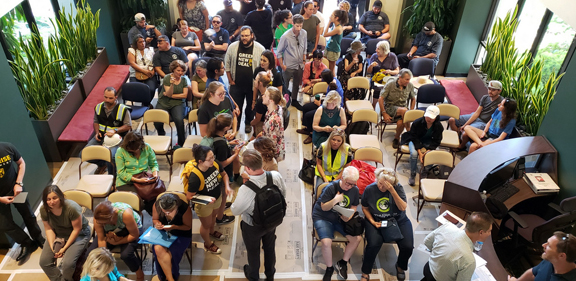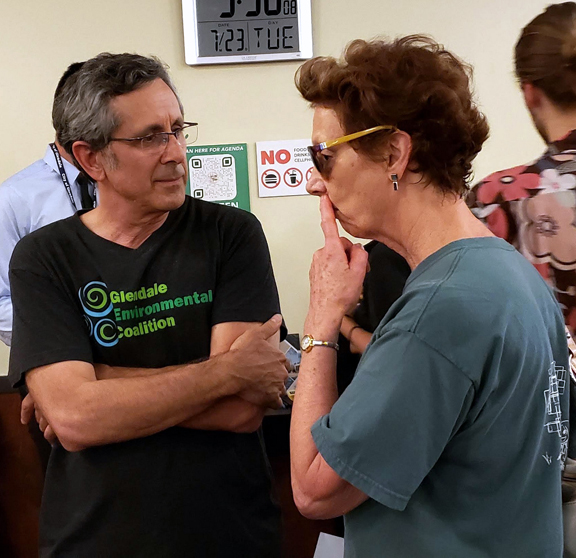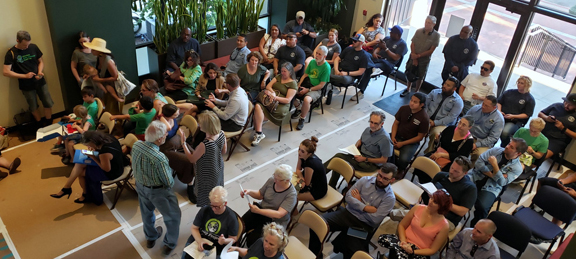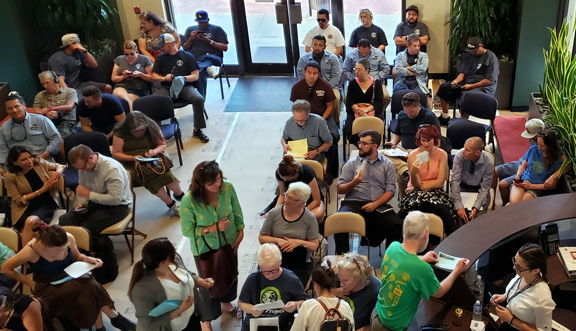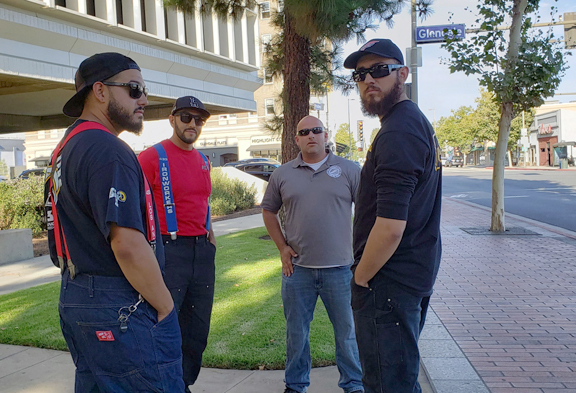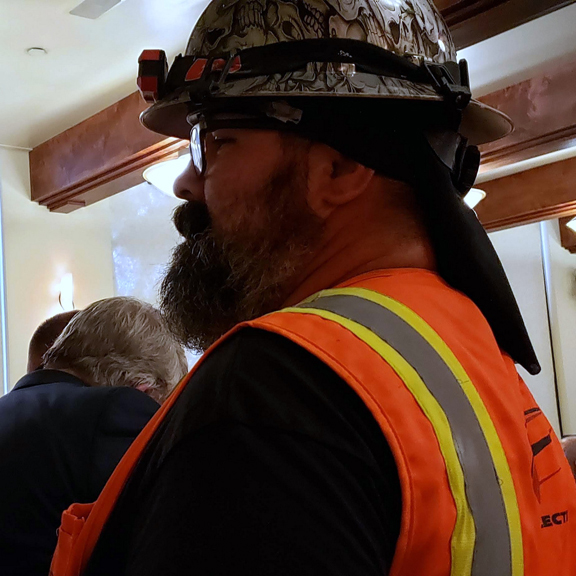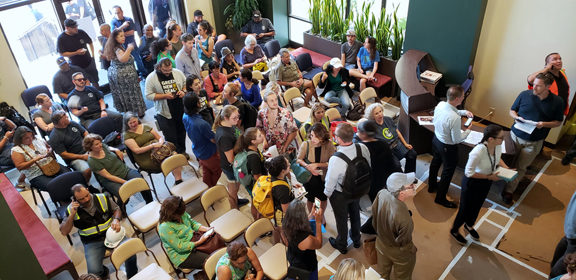
A crowd gathered outside the full council chambers during the Tuesday night meeting that focused on the Grayson Power Plant.
By Julie BUTCHER
On Tuesday night the Glendale City Council voted unanimously to adopt a significantly modified plan for retooling the Grayson Power Plant using a mix of clean and renewable energy along with the much scaled-back utilizing of natural gas.
Last year, Glendale Water and Power (GWP) proposed to rebuild the 80-year-old plant’s geothermal capacity to 262 megawatts, and community members and local environmental activists responded in loud opposition. As a result, at the instruction of the Council, the utility solicited ideas for ideas and solutions to avoid the additional use of fossil fuels, reconsidered numerous options and technologies, and developed this new, more diversified refurbishment plan.
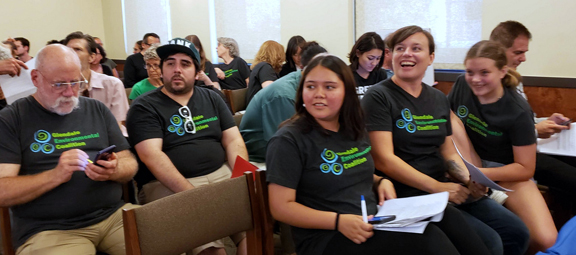
Approved by the citizen commission overseeing GWP in early July, the updated proposal calls for 51 megawatts in distributed energy programs (DREs) – 28 megawatts in energy efficiencies and demand response incentive pricing and 23 megawatts in rooftop solar and storage (including a virtual power plant to tie sources together for optimal energy harnessing); 75 megawatts in battery power and storage (50 megawatts now, 25 more in the future); and 93 megawatts of potential backup electricity delivered via five gas-powered internal combustion engines (ICEs), 18.5 megawatts each.
The introduction of the City’s Integrated Resource Plan (IRP) states “[t]he portfolio will allow GWP to provide its customers with reliable, affordable and environmentally sustainable power and will enable GWP to transition to a 100% clean energy future.”
Approximately 370 people attended a rally outside Glendale City Hall organized by the Glendale Environmental Coalition (GEC) two weeks ago. At this week’s meeting, there were 150 or so in attendance, including about 50 workers from the plant and trades, carpenters, and laborers’ unions.
City Manager Yasmin Beers summarized recent history.
“We were before council in April 2018 with an EIR [environmental impact report] for a natural gas powered repowering project with a battery option to replace the aging generators at Grayson. Council aptly directed staff to go back and find cleaner alternatives; the direction was clear,” she said. “We can be both reliable and green here in the City of Glendale. A repowered Grayson is an integrated part of the plan to move to a 100% clean energy future.”
GWP staff and consultants detailed the updated plans. Gary Dorris of Ascend Analytics commended the council for having “the foresight in having us look into this further. You make significant inroads in addressing climate issues, the environment, while being very cost-effective as well. It’s a wonderful plan that makes a big, bold statement.”
Glendale starts from a point of leadership when it comes to environmental stewardship, Dorris added, comparing the city to its neighbors and other cities.
“Glendale leads its peer group,” he said. “This plan represents a 40% reduction in emissions and a 20% reduction in cost, improving CO2 emissions in one decade, realizing 2030 air quality goals by 2026 and net negative in carbon emissions by 2029.”
Councilmember Vartan Gharpetian emphasized Glendale’s standing in relation to the mix of the energy portfolios of other local cities.
“We’re as good as Pasadena, better than Riverside, Burbank, Anaheim, and Los Angeles,” he said.
GWP general manager Steve Zurn also had comments for the Council.
“When we started a lot of folks said that we were expanding the plant, adding new gas,” Zurn said. “Even the initial recommendation didn’t do that; this proposal reduces both the size of the plant and the amount of gas used. It’s not an expansion. We’re reducing the existing gas, contracting from our current faceplate from 250 megawatts to 93.”
Ash Rosas emotionally spoke during public comment, saying she wanted to make sure her 6-year-old sister could see the stars at night through the smog.
GEC president Dan Brotman, who has announced his bid for a city council seat in the next election, commended the GWP for the movement made by the utility since the Grayson question was last brought to Council.
“A year ago, we were looking at an overly expensive 262-megawatt all-gas project, and now it’s 93 with a sizable investment in clean energy. According to the IRP, the new project is not only cleaner and more flexible but cheaper,” he said. “This speaks to the question of the cost of green energy; it’s a question of timing. The overall project is $174 million cheaper.”
“But we need to remember how this came about,” Brotman continued. “Had the GEC not organized, we would almost certainly be staring down the barrel of an unnecessarily dirty and expensive project. We’re happy with the direction GWP is going but we believe they can do a lot better (as we outlined in our letter). We’re not calling for zero gas, as some have suggested. We understand that Unit 9 and Magnolia will be with us for some time. The day will come when we’ll talk about retiring those units, but that day is not now. We’re also not saying definitively that there’s no need for any new gas; we believe that if the right steps are taken that we will not need any new gas.”
Steve Colton, Glendale resident of “38 years and eight months” urged the council to “work with us.”
“Be inclusive. Please don’t oppose us,” he urged. “We’ve been offering help to host events and to work together. Half the vendors who responded to the Clean Energy RFP responded because we called them.”
Colton shared a chart showing 300 Glendale households ready to participate in the virtual power plant.
Sunrise Movement volunteer Robert Reeves told the Council that the “Sunrise Movement is aimed at stopping climate change and creating millions of good jobs in the process.”
“Science tells us unequivocally that climate change is the most fearsome threat to all life in modern times and that we have a decade to transform our energy grid to 100% renewable, that we must enact radical change across all human activities if we are to navigate the worst of its effects,” said Reeves. “While Mr. Dorris advocates a dirty gas future for Glendale, making us culpable for climate change globally, the LADWP prepares to move forward on the largest and cheapest energy from solar and battery power, the Eland project, to power 7% of LA. Meanwhile, Glendale is stuck in the past, prepared to share a special place as the last city in California seriously considering gas power.”
Another Sunrise activist said, “As our planet is burning, I hope our last words are not, ‘But we saved so much money.’ I’m going to live with the repercussions of decisions made in this room and rooms like it. The technology is changing so rapidly now – it seems ridiculous that with 11 years left of the climate change clock that we couldn’t come up with a better option.”
One of the workers at the Grayson plant read a statement reminding the city of its “legal obligation to provide reliable, efficient and reasonably-priced power. If you reduce the megawatts you can produce, you’ll be inviting disaster. Currently we’re allowed to produce up to 340 megawatts. You’re proposing to reduce that amount permanently. We’d never be able to get that back. Two years ago, the peak load was 340 megawatts. How can you sustain the residents of Glendale when you can’t generate your own power? This plan calls for 93 megawatts plus the 48 we get from Unit 9 and Magnolia; that’s 141 megawatts at max. Yesterday we were at 208, today 266, and tomorrow we’re expecting to be at 282 megawatts. Our highest peak was 347 megawatts on Sept. 1, 2017,” he detailed. “In a severe power outage, you are an island. Everyone around will separate, and they will utilize their own resources for their own citizens until the system stabilizes.”
Ultimately the plan was approved with conditions, requiring GWP to come back for specific approval before purchasing and installing the gas engines and report back regarding serious transmission lines limitations, for instance.
“This firmly establishes GWP as a national clean energy leader. The future envisioned here represents a complete transformation of the way GWP provides reliable, affordable, clean energy,” Mayor Ara Najarian said, commending the large, hot crowd. “This could have been contentious. Instead it was courteous and polite. In doing so, your message came across and we all listened.”

